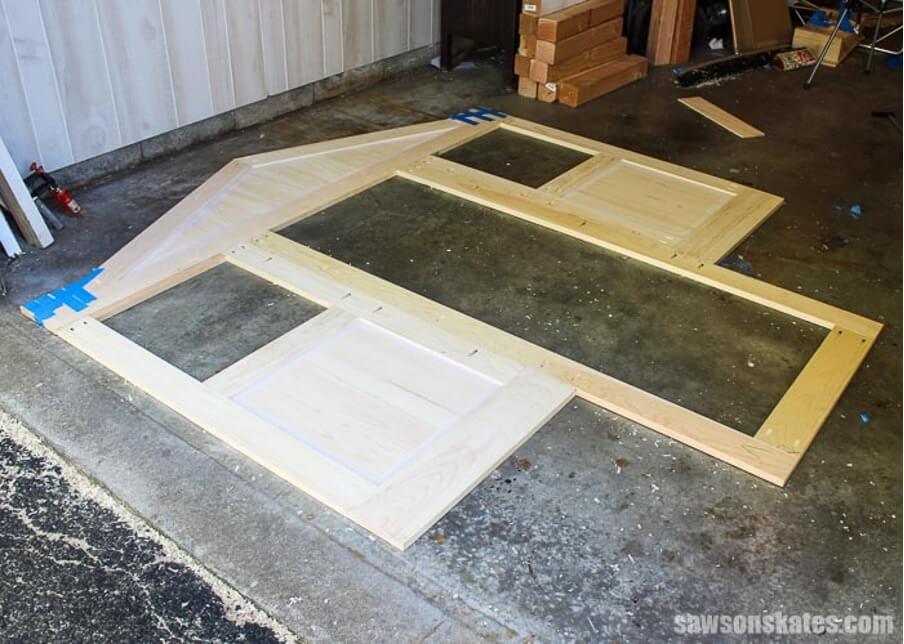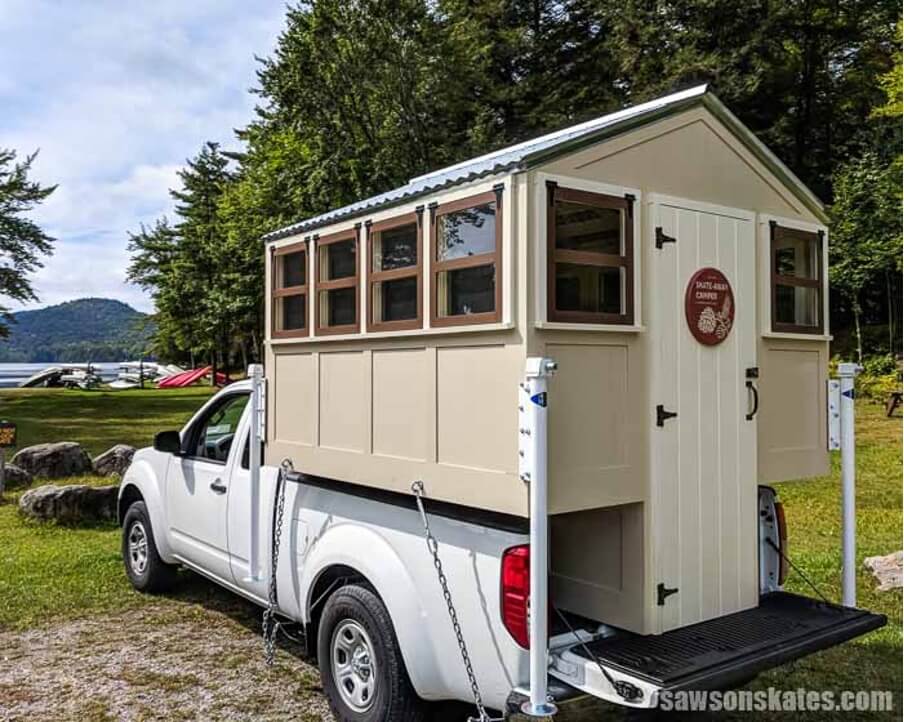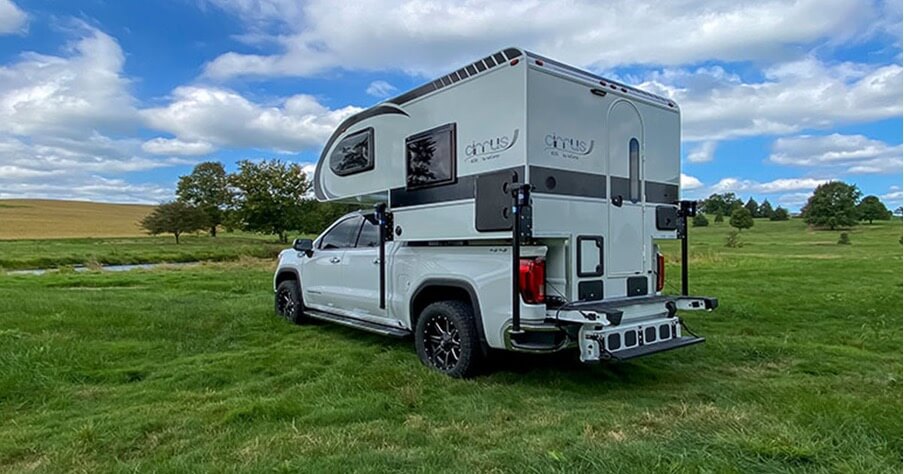Are you considering constructing your truck camper but unsure whether it would be financially beneficial?
A home-built truck camper is a doable Do It Yourself project that is possible to do with the correct designs, resources, and some patience; however, the answer depends on your carpentry skills.
This step-by-step guide will walk you through the process of constructing a lightweight truck camper that can be customized to fit any size truck bed. It will also explain what differentiates a truck camper from other types of recreational vehicles.
If you think this would be interesting, read on for more information!
What is a Truck Camper?
A camper that slides into the bed of your vehicle is known as a truck camper. This type of camper is also known as a slide-in. Truck campers are like backpacks for trucks and typically come equipped with many of the same amenities that are found in standard recreational vehicles (RVs). In most cases, the cabover room includes sleeping space, a little kitchen, and a seating area that is not very large.

Slide-outs are a space-saving feature that can be seen on some truck campers. Some of them feature a canvas tent top that can be popped up, which makes them easier to maneuver on the road and lighter all around.
Features of Truck Camper
The fact that a DIY truck camper has the same ground clearance as a truck is the primary advantage of owning one. This means that your recreational vehicle (RV) can go everywhere your truck can. Because no other type of recreational vehicle can access these areas, truck camper owners have the unique opportunity to camp in some of the world’s most secluded, gorgeous, and tranquil settings.
A great number of people who own truck campers can easily carry along other accessories on trips, thanks to the fact that a truck can have two additional toys. These can be anything from golf carts to four-wheelers to dirt bikes and even more. In addition, the capabilities of each truck in terms of towing are completely unique to that vehicle.
The Bathroom
For potential buyers of recreational vehicles (RVs), the availability of a bathroom is one of the most important considerations. To their owners’ relief, most truck campers come pre-fitted with either a wet or dry bathroom. A dry bath is very analogous to the bathroom found in a house, with the exception that the shower stall is open air. In a wet bath, the toilet and sink are located within the enclosed space that serves as the shower. Because of this, both your toilet and sink will become flooded whenever you take a shower, which is the feature’s primary purpose.
Different Varieties of Truck Campers
There are many kinds of truck campers available on the market, and they can accommodate virtually any need. These truck campers’ range in size from compact pop-up campers to enormous campers that will blow your mind.

Campers For Pickup Trucks with Hard Sides
Truck campers with hard sides slide into the truck’s bed and have an overhang that extends over the truck’s cab. They can be very large or very small, and some even have slide-outs in their design. In addition to this, the walls are solid, and they are of a height that allows you to stand up easily inside of them.
Truck Campers That Can Be Popped Up
In addition, pop-up truck campers are transported in the back of a pickup truck. However, in order to use the camper, you will need to raise the top-up. Pop-up truck campers are a common choice for off-roading since they have a lower center of gravity and are lighter in weight in general. This makes them an attractive option for Overlanding.
These campers have a reduced height so that there is greater headroom and less resistance to the wind. Hard-sided campers often come with more creature comforts and better insulation, but soft-sided campers can fit on trucks with a smaller payload capacity and have a smaller turning radius.
Campers Mounted on Flatbed Trucks
These truck campers have been purpose-built to be transported on the bed of a flatbed truck. Because of this, it is possible to make better use of the area that is normally occupied by the sides of the bed in a conventional pickup truck. It is possible for flatbed truck campers to make use of the additional bed space for more storage or tank capacity rather than the skinnier bottom part.
List of Supplies for Building a DIY Truck Camper

To construct a fundamental DIY truck camper frame, you will require the following materials:
- Framing made of wood 2×4 or 2×2, or aluminum
- Plywood
- Insulation made of foam board or batting
- For the roof, either aluminum foil or rubber sheeting
- Exterior siding (Vinyl or PVC is lightest)
- RV-specific casing for the doors and windows, as well as trim for the roof and siding junctures
- Hardware such as nails, screws, and brackets, in addition to construction adhesive and silicone caulk.
Step By Step to Build the Truck Camper
1. Draft the Truck Camper

Your design should be laid out in accordance with your preferences, but you should always keep in mind the requirement to cut down on unnecessary weight wherever possible. The first concern should be minimizing the amount of weight carried by the camper. Also, choose the kind of electrical system that you want, if you want one at all. There is additional information on the camper’s electrical systems in the part that may be found below.
The very last choice you’ll have to make during the design phase is whether the camper will be able to fit totally within the walls of your truck bed or if you’ll be installing lift jacks instead. For lifts, you will need to make the side overhangs substantial enough so that your vehicle can easily pass underneath.
2. Cut and assemble the Truck Camper Frame

Many folks choose either 2×2 or 2×4 lumber to construct the frame. However, if cost is not an issue, aluminum framing is an excellent option because it is strong without being excessively heavy.
You can create the framework for your project directly inside the bed of your truck, or you can construct it in a garage where it will stand on its own. If you decide to go with a free-stand build, you might be required to make use of some props in order to stabilize the structure before you can place your lift and stabilizing jacks.
If you want your framing to be able to endure the bumps and vibrations that are created by driving, make sure you use a lot of high-quality screws and adhesive when you put it together.
3. Cover the Truck Camper Frame with Plywood

Plywood is long-lasting and will transform your frame, which is currently rather unstable, into a box that is rigid. This is not the outside finish that will be seen in the end; rather, it is what creates the sturdy structural base of your camper.
To ensure that the plywood is firmly attached to the frame, use an abundance of adhesive and screws, just like you did with the framing. Your camper will have a longer lifespan if it has a more robust structure.
When the siding is finished, you will then cut any openings for windows and doors according to the plan you created initially.
4. Install any Pipes or Wires Necessary for the Plumbing or Electricity
Electrical systems in truck campers might either not exist at all, be solar-powered, operate on 12 volts and be powered by batteries, or operate on 110 volts. Now is the time to run your wiring if you want to have power later, which you should decide now.
Most recreational vehicles, regardless of type, are powered by a combination of 12-volt and 110-volt systems. So even when the camper is not connected to an external power source that operates at 110 volts, the 12-volt system will continue to power the lights until the batteries run out of juice.
5: Complete the Interior Amenities
Constructing or putting in place any conveniences you have in mind for the interior of your dwelling is necessary. For example, you may use ordinary cabinetry for storage, or you could design bespoke objects that can serve several purposes, such as a bench with tops that can be flipped up to reveal more storage space underneath. Then, simply add a cushion to it, and you’ve got yourself some cozy seats.
6: Complete Work on the Outside of the Truck Camper

Roofing materials and weather-proof tape are widely accessible in camping supply stores as well as online. Both items are expected to last for several years.
Your unique sense of style can be expressed through the choice of siding treatment. Siding can be made from a variety of materials, including wood, metal, and even logs that have been split.
Most people go with fiberglass panels, which may also be referred to as Filon, and attach to the plywood using a powerful adhesive. Typically, this clapboard is sold by the foot from rolls and looks like this:
Aluminum panels, which can either be smooth or textured, are yet another well-liked choice.
7: Install the Lift Jack for the Truck Camper
To finish the interior space, install thin paneling and standard trims, then paint or stain according to your preferences. Install any additional shelving, hooks, and latches to ensure your gear is stored safely.
On top of the plywood floor you currently have, now is the time to install flooring such as carpet, laminate, or hardwood.
If you will be utilizing lift jacks, ensure that the equipment is installed according to the manufacturer’s instructions and that it is tested for functionality.
Benefits of Using DIY Truck Campers
Truck campers are extremely useful recreational vehicles because of their versatility, making traveling much less difficult. The following are the most significant benefits:
- You can park pretty much wherever. Because the camper is stored in the truck bed, you will have the ability to park in virtually any parking spot, even in the most congested districts of the city.
- It is simple to operate. Truck campers are rather simple vehicles to operate. Driving a truck camper is not significantly more difficult than driving the truck itself if you consider your height, weight, and the location of your center of gravity. Because they are mounted directly in the truck bed, they are also very simple to maneuver.
- The home and the car are two independent entities. You can do your touring in the truck while the camper is unloaded, so you won’t have to worry about packing up camp or bearing the additional weight of the camper. Because you drive a very capable truck, there are very few places in the world that you cannot go. You will still have somewhere to live, even if your truck needs to go into the shop for maintenance since you will have the camper.
Owning a DIY Truck Camper in the Long Run
Truck campers are immediately less expensive than any other recreational vehicle (RV) form, making them a realistic solution for travelers on a budget.
If you already have a truck, purchasing this kind of camper will be an even better financial decision for you. It is also less expensive and more convenient to store a truck camper, regardless of whether it is a hard-sided or pop-up model, in comparison to storing other larger classes of RVs.
During the off-season, these can be conveniently stored away in a garage or another storage facility of the same size.

